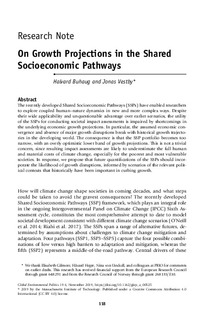| dc.description.abstract | The recently developed Shared Socioeconomic Pathways (SSPs) have enabled researchers to explore coupled human–nature dynamics in new and more complex ways. Despite their wide applicability and unquestionable advantage over earlier scenarios, the utility of the SSPs for conducting societal impact assessments is impaired by shortcomings in the underlying economic growth projections. In particular, the assumed economic convergence and absence of major growth disruptions break with historical growth trajectories in the developing world. The consequence is that the SSP portfolio becomes too narrow, with an overly optimistic lower band of growth projections. This is not a trivial concern, since resulting impact assessments are likely to underestimate the full human and material costs of climate change, especially for the poorest and most vulnerable societies. In response, we propose that future quantifications of the SSPs should incorporate the likelihood of growth disruptions, informed by scenarios of the relevant political contexts that historically have been important in curbing growth.
How will climate change shape societies in coming decades, and what steps could be taken to avoid the gravest consequences? The recently developed Shared Socioeconomic Pathways (SSP) framework, which plays an integral role in the ongoing Intergovernmental Panel on Climate Change (IPCC) Sixth Assessment cycle, constitutes the most comprehensive attempt to date to model societal development consistent with different climate change scenarios (O’Neill et al. 2014; Riahi et al. 2017). The SSPs span a range of alternative futures, determined by assumptions about challenges to climate change mitigation and adaptation. Four pathways (SSP1, SSP3–SSP5) capture the four possible combinations of low versus high barriers to adaptation and mitigation, whereas the fifth (SSP2) represents a middle-of-the-road pathway. Central drivers of these challenges include changes in demographic, economic, technological, social, political, and environmental factors.
The SSPs serve two key functions: to provide “a basis for integrated scenarios of emissions and land use” and to facilitate “climate impact, adaptation and vulnerability analyses” (O’Neill et al. 2017, 169). There is some tension between these functions, since the former is determined mostly by the development trajectories of large economies and major greenhouse gas (GHG) emitters, whereas the latter is much more sensitive to future development in low-income countries and the world’s poor. In other words, there is little overlap between the countries that contribute the most to anthropogenic climate change and those that are the most vulnerable to its impacts (Althor et al. 2016). Presently, the SSP framework appears better suited to fulfilling the first task than the second.
In this research note, we show that existing quantifications of the SSPs, despite their wide applicability and unquestionable advantage over earlier scenario exercises, have clear limitations for researchers seeking to conduct societal adaptation and impact assessments because of shortcomings in the economic growth models underlying the SSPs. In particular, the assumption of growth convergence, whereby poorer countries gradually catch up with wealthy economies as long as educational attainment improves, and the related assumption of a future without major growth disruptions break with historical development trajectories. The result is an overly narrow and optimistic range of projected development outcomes. In response, we encourage revising or expanding the SSPs to incorporate growth projections that are sensitive to the underlying political and security contexts. Assumptions about such conditions are already embedded in the narratives that accompany the quantified SSPs (O’Neill et al. 2014, 2017), but presently, they exist in isolation from the growth projections. By bringing the political context explicitly into the quantitative scenarios, the SSP modeling community would help the IPCC get one step closer to achieving its objective: “to provide governments at all levels with scientific information that they can use to develop climate policies.” | nb_NO |

